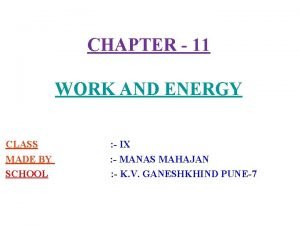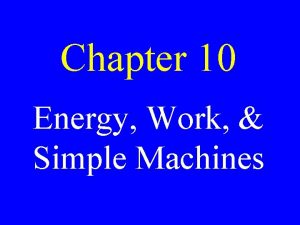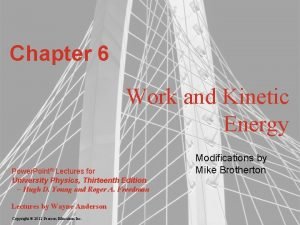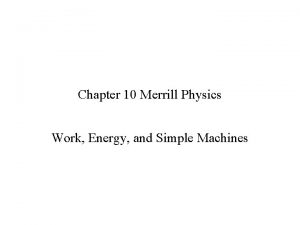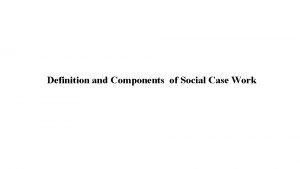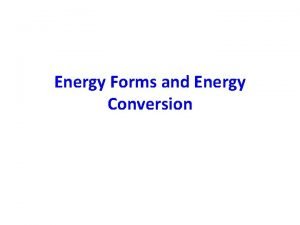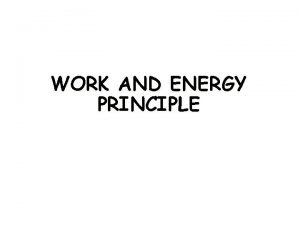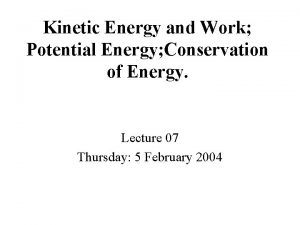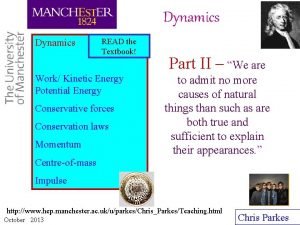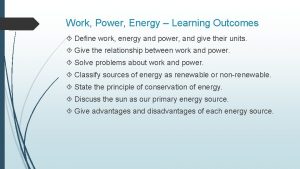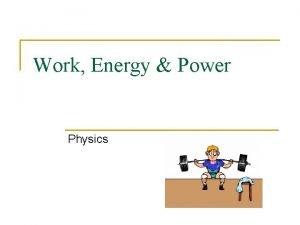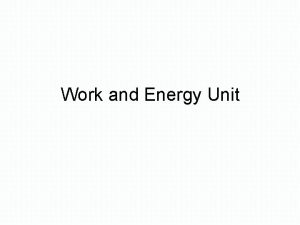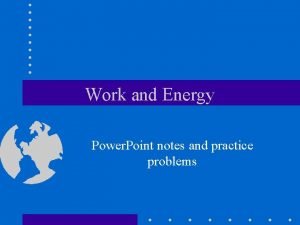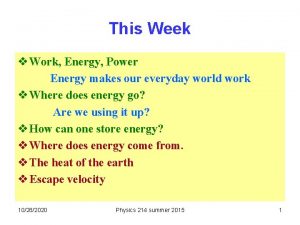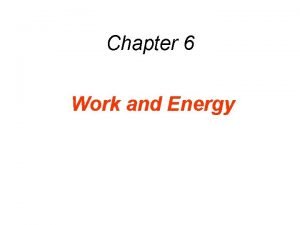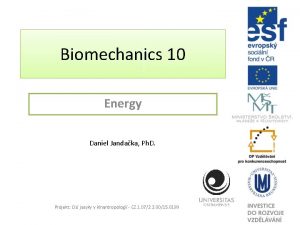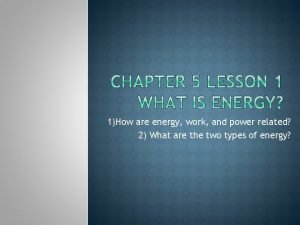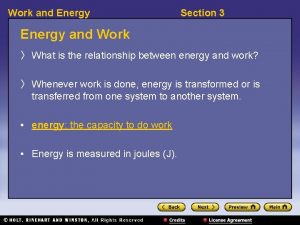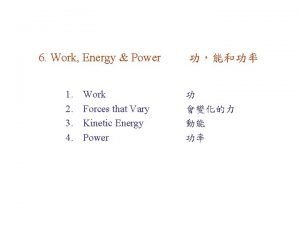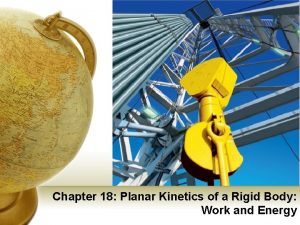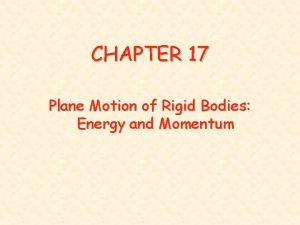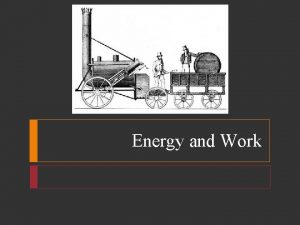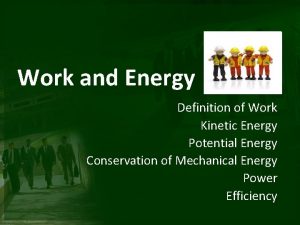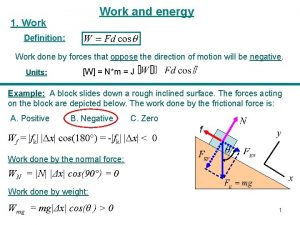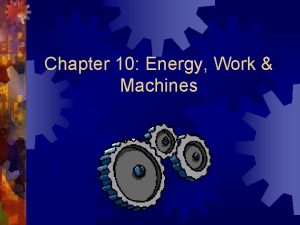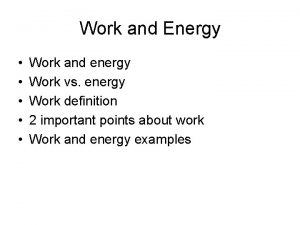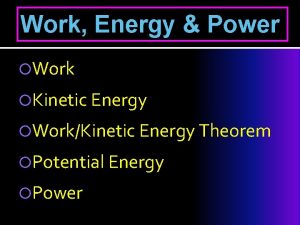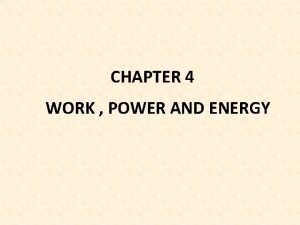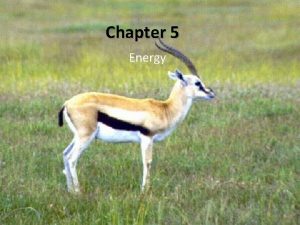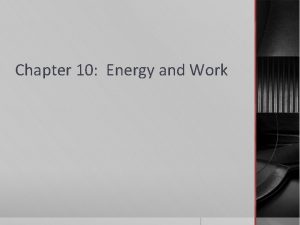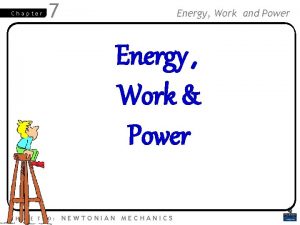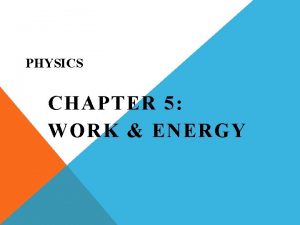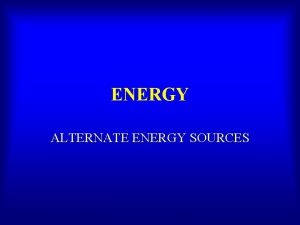Chapter 5 Work and Energy Definition of Work














































- Slides: 46

Chapter 5 Work and Energy

Definition of Work n There is a difference between the ordinary definition of work and the scientific definition of work n Ordinary Definition: To do something that takes physical or mental effort n Scientific definition: Work is equal to the magnitude of the applied force times the displacement of an object

What is necessary for work to be done? n A force that causes displacement of an object does work on the object n Therefore, work is not done on an object unless the object is moved because of the action of a force Work is being done!!!

What is necessary for work to be done? n Work is done only when components of a force are parallel to a displacement n When the force on an object and the object’s displacement are perpendicular, no work is done No Work was Done!!! Displacement Force

What about forces at an angle? n Only the component of force that is parallel to the direction of the object’s displacement does work. n Example: A person pushes a box across a frictionless floor

FBD For the Box n What part of the applied force is parallel to the displacement? FN Displacement of Box Fapp, y Fapp Fg

General Equation For Work Done Work= Component of Force that does the work x displacement x cos (angle between the force vector and the displacement)

Net Work done by a Constant Force n If there are many constant forces acting on the object, you can find the net work done by finding the net force acting on the object Net work= Net force x displacement x cos of the angle between them

Angles between vectors Vector Orientation Angle between them Cos(θ) Θ= 90 Cos(90) =0 Θ= 0 Cos(0) = 1 Θ= 180 Cos(180) = -1

Units for Work n The unit for Work is the Joule n I J= 1 Nm n One Joule = One Newton x One meter

The sign of work is important n Work is a scalar quantity, but it can be positive or negative n Work is negative when the force is in the direction opposite the displacement n For example, the work done by the frictional force is always negative because the frictional force is opposite the displacement

Sample Problem p. 193 # 10 n A flight attendant pulls her 70 N flight bag a distance of 253 m along a level airport floor at a constant velocity. The force she exerts is 40. 0 N at an angle of 52. 0° above the horizontal. Find the following: The work she does on the flight bag n The work done by the force of friction on the flight bag n The coefficient of kinetic friction between the flight bag and the floor n

FBD FN Fapp, y Ff Fapp, x Fg

Work done by flight attendant n Only the component of Fapp that is parallel to the displacement does work. n n Fapp, x is parallel to the displacement Fapp, x = 40 cos 52 = 24. 63 N n Remember that in the W=Fdcosθ equation, θ represents the angle between the force vector and the displacement vector Fapp, x d n W= (24. 63 N)(253 m) cos(0)= 6230 J Θ = 0°

Work done by friction n The bag is moving at constant velocity, so what is Ff? n Ff = Fapp, x= 40 cos(52)= 24. 62 N Ff n d Θ =180° W= Fdcosθ= (24. 62 N)(253 m)(cos 180) = -6230 J

Find μk n What is FN? n Fn + Fapp, y = Fg n Fn = Fg - Fapp, y= 70 N- 40 sin(52)= 38. 48 N

Energy- Section 5. 2 p. 172 n Kinetic Energy- The energy of an object due to its motion I Have Kinetic Energy I don’t Have Kinetic Energy

Kinetic Energy Depends on Speed and Mass n Kinetic energy = ½ x mass x speed 2 n The unit for KE is Joules (J)

Sample Problem p. 173 n A 7. 00 kg bowling ball moves at 3. 0 m/s. How much kinetic energy does the bowling ball have? How fast must a 2. 45 g tennis ball move in order to have the same kinetic energy as the bowling ball?

Solve the Problem n KE= ½ mv^2= ½ (7 kg)(3 m/s)^2= 31. 5 J n How fast must 2. 45 g ball move to have the same KE? n n Convert g to kg 2. 45 g =. 00245 kg Solve for v

Work-Kinetic Energy Theorem n The net work done by a net force acting on an object is equal to the change in kinetic energy of the object n You must include all the forces acting on the object for this to work!

Sample problem p. 176 #2 n A 2000 kg car accelerates from rest under the actions of two forces. One is a forward force of 1140 N provided by the traction between the wheels and the road. The other is a 950 N resistive force due to various frictional forces. Use the work-KE theorem to determine how far the car must travel for its speed to reach 2. 0 m/s.

What information do we have? n M= 2000 kg n Vi= 0 m/s n Vf= 2 m/s Ffriction= 950 N Fforward= 1140 N

What is the Work-Ke Theorem? n Remember that: n So Expand the equation to this:

n Solve for Fnet n Fnet= Fforward- Ffriction= 190 N forward n Rearrange the equation for d and plug in values n Why is θ= 0 in the denominator? Because the net force is in the same direction as the displacement.

Potential Energy Section 5. 2 n Potential Energy is stored energy n There are two types of PE n Gravitational PE n Elastic PE

Gravitational Potential Energy n Gravitational Potential Energy (PEg) is the energy associated with an object’s position relative to the Earth or some other gravitational source n

Elastic Potential Energy n Elastic Potential Energy (PEelastic) is the potential energy in a stretched or compressed elastic object. n k= spring (force) constant n X= displacement of spring

Displacement of Spring

Sample Problem p. 180 #2 n The staples inside a stapler are kept in place by a spring with a relaxed length of 0. 115 m. If the spring constant is 51. 0 N/m, how much elastic potential energy is stored in the spring when its length is 0. 150 m?

What do we know? n K = 51. 0 N/m n We need to get x, in order to use the equation for elastic PE n X is the distance the spring is stretched or compressed n Relaxed length is 0. 115 m, stretched length is 0. 150. How much was it stretched? n 0. 150 - 0. 115 m= 0. 035 m= x

Solve the problem

Conservation of Energy – 5. 3 n The total amount of energy in the universe is a constant n So we say that energy is conserved n From IPC: The Law of Conservation of Energy: Energy can neither be created nor destroyed

Mechanical Energy n There are many types of energy (KE, PE, Thermal, etc) n We are concerned with Mechanical Energy n Mechanical Energy is the sum of kinetic energy and all forms of potential energy n ME= KE + PE

Conservation of ME n In the absence of friction, mechanical energy is conserved n When friction is present, ME can be converted to other forms of energy (i. e. thermal energy) so it is not conserved.

Expanded Form of Conservation of ME n Without elastic PE n With elastic PE

Practice Problem p. 185 #2 n A 755 N diver drops from a board 10. 0 m above the water’s surface. Find the diver’s speed 5. 00 m above the water’s surface. Find the diver’s speed just before striking the water.

What do we know? n W= 755 N n Initial height = 10 m n Vi= 0 m/s n There is no elastic PE involved.

Solve part a. n What is the diver’s speed 5. 0 m above the water’s surface? n M= Weight/g=76. 96 kg n Vi= 0 m/s n Initial height = 10 m n Final Height = 5 m

Rearrange equation and solve for vf Vi = 0 m/s

Second Part n What is the diver’s speed just before striking the water? n M= Weight/g=76. 96 kg n Vi= 0 m/s n Initial height = 10 m n Final Height = 0 m

Finish the Problem Vi = 0 m/s hf = 0

Power- Section 5. 4 n Power: The rate at which work is done n The unit for power is Watts n 1 Watt = 1 J 1 s

Alternate Form for Power

Sample Problem (Not in book) n At what rate is a 60 kg boy using energy when he runs up a flight of stairs 10 m high in 8. 0 s? n Time = 8 s n What is work done? n W=Fdcos(θ)

Solve the Problem n What force does the boy apply to get himself up the stairs? F= Weight= mg= 588. 6 N n d= 10 m n n W= Fdcos(θ)=588. 6 N(10 m)(cos(0)) n W=5886 J n P=W/t = 5886 J/ 8 s= 735. 8 Watts
 Section 4 review physical science
Section 4 review physical science Energy energy transfer and general energy analysis
Energy energy transfer and general energy analysis Energy energy transfer and general energy analysis
Energy energy transfer and general energy analysis Section 2 describing energy
Section 2 describing energy Physics 03-01 work and the work-energy theorem
Physics 03-01 work and the work-energy theorem Chapter 11 work and energy
Chapter 11 work and energy Ma=fr/fe
Ma=fr/fe Chapter 10 energy, work and simple machines answer key
Chapter 10 energy, work and simple machines answer key Energy work and simple machines chapter 10 answers
Energy work and simple machines chapter 10 answers Chapter 6 work and energy powerpoint
Chapter 6 work and energy powerpoint Chapter 10 work energy and machines
Chapter 10 work energy and machines W=fdcosθ meaning
W=fdcosθ meaning Work and power definition
Work and power definition Chapter 7 energy conservation of energy
Chapter 7 energy conservation of energy Social case work meaning
Social case work meaning Primary energy and secondary energy
Primary energy and secondary energy Disadvantages of conventional energy
Disadvantages of conventional energy Helmholtz free energy and gibbs free energy
Helmholtz free energy and gibbs free energy Renewable energy and energy efficiency partnership
Renewable energy and energy efficiency partnership Example of kinetic energy
Example of kinetic energy You and your friend both solve a problem involving a skier
You and your friend both solve a problem involving a skier Formula of potential energy
Formula of potential energy The change in mechanical energy
The change in mechanical energy Energy forms and energy conversions
Energy forms and energy conversions Ads=vdv example
Ads=vdv example W=uf-ui
W=uf-ui Work and energy chart
Work and energy chart Work and potential energy
Work and potential energy Learning objectives of work and energy
Learning objectives of work and energy Sound energy definition
Sound energy definition Work is change in energy
Work is change in energy Work, power and energy activities
Work, power and energy activities Unit of work and energy
Unit of work and energy Work and energy powerpoint
Work and energy powerpoint F= ma units
F= ma units Joule units
Joule units Energy enables you to work and play
Energy enables you to work and play Work and energy
Work and energy Energy biomechanics definition
Energy biomechanics definition How are work and power related
How are work and power related Work and energy section 2
Work and energy section 2 Work power energy and machines
Work power energy and machines Work power and energy
Work power and energy Planar kinetics of a rigid body work and energy
Planar kinetics of a rigid body work and energy Principle of work and energy for rigid body
Principle of work and energy for rigid body Starting from rest a child zooms down
Starting from rest a child zooms down A slingshot consists of a light leather cup
A slingshot consists of a light leather cup





